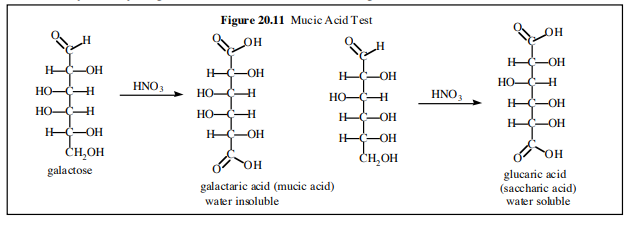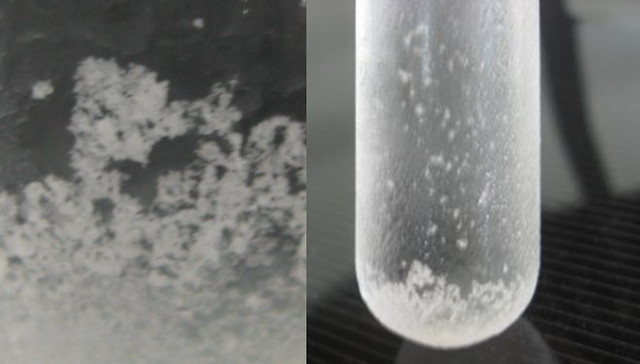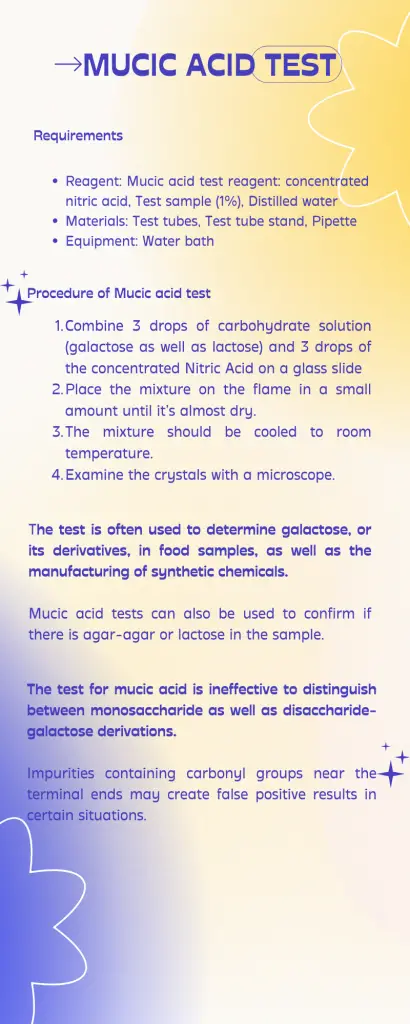Table of Contents
Mucic acid test tests for lactose and galactose. The sugar is transformed into carboxylic acid using hot nitric acid. In order to produce dicarboxylic acids, aldoses are oxidized on each end of the open ring form.
Chain fragmentation triggers ketoses to oxidize and produce a range of dicarboxylic acid. Galactraric acid (mucic acid) created by the oxidation process of galactose has lower solubility within the oxidising media (including water) than saccharic acid produced through other aldoses. This is due to its high molecular symmetry.
Purpose of Mucic acid test
- To identify whether there is galactose or lactose within a particular sample.
- To differentiate between galactose with saccharides as well as other sugars.
Principle of Mucic acid test
Monosaccharides, such as galactose contain sugars, such as lactose has a positive response to this chemical reaction. In the presence of acidic substances such as nitric acid create saccharic acids. The saccharic acid produced is insoluble and forms clear crystals. The acid derivative is known as meso-galactaric or galactaric acid (mucic acid) and hence the name of the test.

Requirements
- Reagent: Mucic acid test reagent: concentrated nitric acid, Test sample (1%), Distilled water
- Materials: Test tubes, Test tube stand, Pipette
- Equipment: Water bath
Procedure of Mucic acid test
- Combine 3 drops of carbohydrate solution (galactose as well as lactose) and 3 drops of the concentrated Nitric Acid on a glass slide
- Place the mixture on the flame in a small amount until it’s almost dry.
- The mixture should be cooled to room temperature.
- Examine the crystals with a microscope.
Results of Mucic acid test

- Positive Result: The development of crystals on the bottom of the tube is an increase in the amount of crystal, which indicates that the sample solution contains galactose , or derivatives of it.
- Negative Result: A lack of crystals signifies a negative outcome and means that the sample does not contain galactose, or its derivative. It could be that the solution contains other carbohydrate.
Uses of Mucic acid test
- The test is often used to determine galactose, or its derivatives, in food samples, as well as the manufacturing of synthetic chemicals.
- Mucic acid tests can also be used to confirm if there is agar-agar or lactose in the sample.
Limitations of Mucic acid test
- The test for mucic acid is ineffective to distinguish between monosaccharide as well as disaccharide-galactose derivations.
- Impurities containing carbonyl groups near the terminal ends may create false positive results in certain situations.

References
- http://myweb.liu.edu/~nmatsuna/che122/exp20.pdf
- https://pubchem.ncbi.nlm.nih.gov/compound/Galactaric-acid
- https://mynotesarchive.wordpress.com/2012/02/18/chem-lab-notes/
- http://www.expertsmind.com/questions/what-is-mucic-acid-test-and-its-principle-30180071.aspx
- https://www.scribd.com/doc/316523242/Mucic-Acid-Test
- http://generalchemistrylab.blogspot.com/2011/12/mucic-acid-test-for-galactose.html
- https://www.thestudentroom.co.uk/showthread.php?t=1957903
- https://noteshippo.com/mucic-acid-test-protocol-principle-procedure-result-applications/
- https://biochemden.com/color-reactions-of-carbohydrates/
